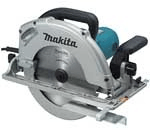Power Saws Information
Power saws are tools that cut and shape material such as wood, metal, and ceramics. Applications for power saws include building and construction, fabrication, as well as maintenance and repair. They are often used with hand tools and other power tools.
Operation
 The primary function of power saws is to cut lumber, metal, plastics, and ceramics to length. These tools rely on motors or engines and a blade to cut and shape the material. AC-powered saws have various power outputs but are restricted to a set distance from a power source. Battery-powered saws have the advantage of being portable and easily, yet they are limited to the battery capacity. Gas-powered saws provide the highest about of power while being portable.
The primary function of power saws is to cut lumber, metal, plastics, and ceramics to length. These tools rely on motors or engines and a blade to cut and shape the material. AC-powered saws have various power outputs but are restricted to a set distance from a power source. Battery-powered saws have the advantage of being portable and easily, yet they are limited to the battery capacity. Gas-powered saws provide the highest about of power while being portable.
Types of Power Saws
There are multiples types of power saws.
- Chain saws: A chainsaw uses a sharpened chain as a blade to cut wood.
- Handheld circular saw: Circular saws generally use metal blades spinning at high speeds to cut wood or metal.
- Chop saw: Chop saws are powerful saws that can cut through many different materials and generally use an abrasive disc for a blade.
- Miter saw: Miter saws are used to cut sharp and perfect angles. This is completed by having a movable and rotating base and blade.
- Pole saw: A pole saw is a power saw usually a small chain saw that is built on the end of a long pole. It can have its length adjusted to get at areas that are too far away to use a hand held saw.
- Reciprocating saw: A reciprocating saw use a straight blade that is reciprocated at high speed. Reciprocating saws have a wide variety of blades that can cut through most materials.
- Table saw: Table saws are tables that have a saw built into them. The blade can be raised from the table and used to cut materials such as wood. Table saws usually have guides built in to accommodate many different sizes and shapes of material.
Configurations
Power saws are commonly made of an electric motor or gas engine, a metal frame, and plastic components. They are generally handheld, benchtop, or freestanding and are available in various blade sizes. The most prominent components of a power saw are the saw blade that cuts the material, and the power source that determines the power and portability of the tool.
Specifications
The follow specifications determine the functionality of a power saws.
- Blade size: The size of the blade either diameter for a circular blade or length for a straight blade.
- Cutting capacity: The size of material the saw can accommodate.
- Weight: The physical weight of the saw.
